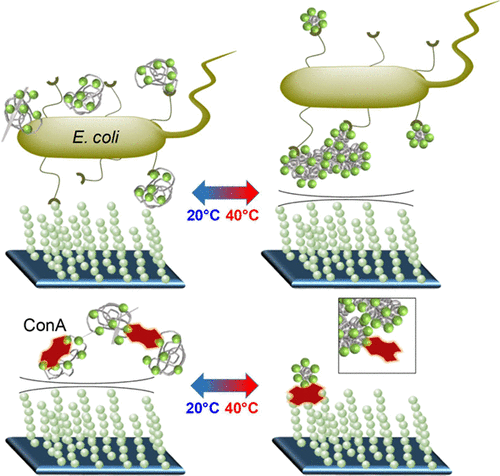当前位置:
X-MOL 学术
›
Biomacromolecules
›
论文详情
Our official English website, www.x-mol.net, welcomes your
feedback! (Note: you will need to create a separate account there.)
Temperature-Switchable Glycopolymers and Their Conformation-Dependent Binding to Receptor Targets.
Biomacromolecules ( IF 5.5 ) Pub Date : 2020-06-16 , DOI: 10.1021/acs.biomac.0c00676 Tanja J Paul 1 , Alexander K Strzelczyk 1 , Melina I Feldhof 1 , Stephan Schmidt 1
Biomacromolecules ( IF 5.5 ) Pub Date : 2020-06-16 , DOI: 10.1021/acs.biomac.0c00676 Tanja J Paul 1 , Alexander K Strzelczyk 1 , Melina I Feldhof 1 , Stephan Schmidt 1
Affiliation

|
The temperature-dependent binding of copolymers from poly(N-isopropylacrylamide) (PNIPAM) and mannose ligands to Escherichia coli and concanavalin A (ConA) is determined. Through polymer analogous reactions using poly(N-acryloxysuccinimide) and amine-linked mannose residues with different linkers, glycopolymers are prepared with the variation of the mannose density. Quantitative adhesion inhibition assays show the inhibitory potential of the glycopolymers as a function of the mannose/NIPAM ratio and linker type above and below their lower critical solution temperature (LCST). Intriguingly, opposite temperature effects on the binding to E. coli and ConA are observed. While the E. coli inhibition is stronger above the LCST, the ConA inhibition is, in overall, weaker at elevated temperatures. When going beyond the LCST, the polymers undergo a coil-to-globule transition, forming microphases with surface-enriched hydrophilic sugar moieties exhibiting increased E. coli inhibition through steric shielding. However, the formation of such microphases above the LCST renders a fraction of carbohydrate ligands inaccessible,and the polymers remaining in the solution phase then have coil sizes below the minimum binding site spacing of the ConA receptor, explaining reduced ConA inhibition. Overall, these results suggest that the coil-to-globule transition of glycopolymers may induce lower or higher inhibitory potentials due to the adverse effects of steric shielding and carbohydrate ligand accessibility.
中文翻译:

温度可转换的糖聚合物及其与受体靶标的构象依赖性结合。
确定了聚(N-异丙基丙烯酰胺)(PNIPAM)和甘露糖配体与大肠埃希菌和伴刀豆球蛋白A(ConA)的温度依赖性结合。通过使用聚(N-丙烯酰氧基琥珀酰亚胺)和具有不同接头的胺连接的甘露糖残基的聚合物类似反应,制备了甘露糖密度变化的糖聚合物。定量粘附抑制测定法显示,糖聚合物的抑制潜能取决于甘露糖/ NIPAM比和接头类型在其最低临界溶液温度(LCST)上下的函数。有趣的是,观察到相反的温度效应对大肠杆菌和ConA的结合。而大肠杆菌抑制作用比LCST强,而ConA抑制作用在高温下总体上较弱。当超出LCST时,聚合物会经历从盘绕到球的过渡,形成具有表面富集的亲水糖部分的微相,表现出增加的大肠杆菌通过空间屏蔽进行抑制。但是,在LCST上方形成此类微相会导致一部分碳氢化合物配体难以接近,并且留在溶液相中的聚合物的卷曲尺寸低于ConA受体的最小结合位点间距,这说明ConA抑制作用降低。总体而言,这些结果表明,由于空间屏蔽和碳水化合物配体可及性的不利影响,糖聚合物的盘绕-向球状转变可能诱导更低或更高的抑制电位。
更新日期:2020-07-13
中文翻译:

温度可转换的糖聚合物及其与受体靶标的构象依赖性结合。
确定了聚(N-异丙基丙烯酰胺)(PNIPAM)和甘露糖配体与大肠埃希菌和伴刀豆球蛋白A(ConA)的温度依赖性结合。通过使用聚(N-丙烯酰氧基琥珀酰亚胺)和具有不同接头的胺连接的甘露糖残基的聚合物类似反应,制备了甘露糖密度变化的糖聚合物。定量粘附抑制测定法显示,糖聚合物的抑制潜能取决于甘露糖/ NIPAM比和接头类型在其最低临界溶液温度(LCST)上下的函数。有趣的是,观察到相反的温度效应对大肠杆菌和ConA的结合。而大肠杆菌抑制作用比LCST强,而ConA抑制作用在高温下总体上较弱。当超出LCST时,聚合物会经历从盘绕到球的过渡,形成具有表面富集的亲水糖部分的微相,表现出增加的大肠杆菌通过空间屏蔽进行抑制。但是,在LCST上方形成此类微相会导致一部分碳氢化合物配体难以接近,并且留在溶液相中的聚合物的卷曲尺寸低于ConA受体的最小结合位点间距,这说明ConA抑制作用降低。总体而言,这些结果表明,由于空间屏蔽和碳水化合物配体可及性的不利影响,糖聚合物的盘绕-向球状转变可能诱导更低或更高的抑制电位。











































 京公网安备 11010802027423号
京公网安备 11010802027423号